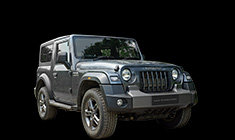News
Detailed look: The making of a sim racing setup
Sim racing hardware and software is now so advanced, it will make you hate your car, curse the roads and middle finger the service-due indicator.
BHPian Electromotive recently shared this with other enthusiasts.
Sim Racing: At the edge of reality.
Dear BHPians,
Let me update you on the current state of sim racing technology. Over the past 5 years sim racing has been growing in leaps and bounds and jumpin' around. Sim racing hardware and software is now so advanced, it will make you hate your car, curse the roads and middle finger the service-due indicator. And of course, you can drink and sim race without consequences (liver health be damned).
I will be mentioning a bunch of companies and products but I am in no way affiliated with them and there is no way for me to profit from this free publicity I am giving them, since most (all?) of this drool-worthy gear is not available in this holy land of bovines. With the disclaimer out of the way, let's get started.
Image: Example of a sim racing setup. Are you drooling?
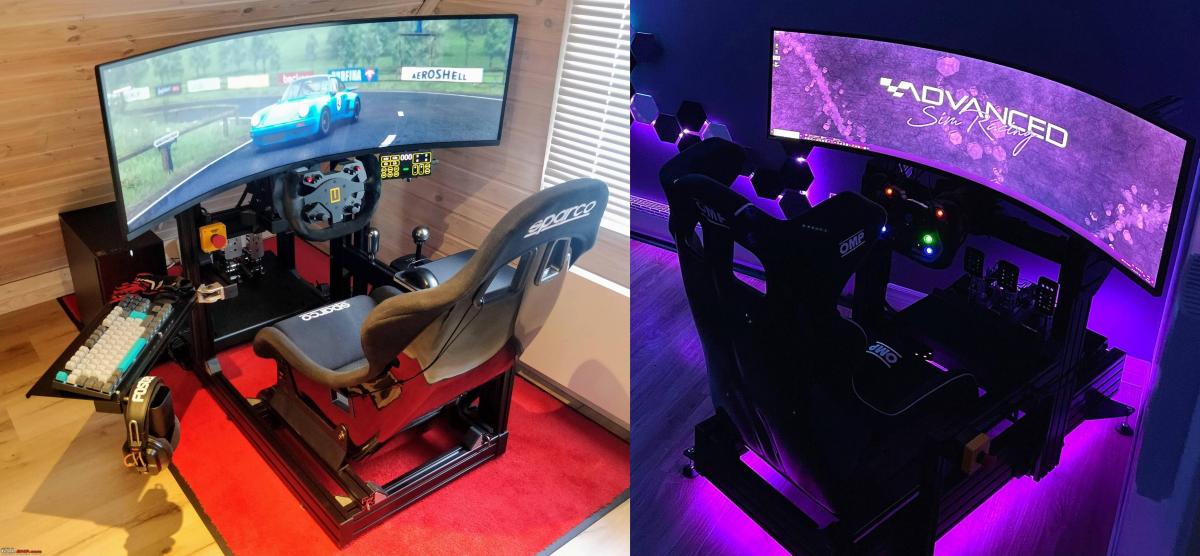
Wheel base:
At the heart of a sim racing setup is something called the wheel base. This is the equipment to which the steering wheel is connected. The most advanced and realistic feeling wheel bases use Direct Drive (DD) technology for force feedback. A Direct Drive wheel base is basically a powerful DC motor with a steering wheel connected to the shaft. There is also a rotary encoder (generally a Hall or optical sensor) mounted on the other end of the shaft that helps track the degree of rotation. The motor is controlled via a controller board using pulse width modulation and a bunch of software magic. The wheel base has its own power supply and connects to the computer or console via USB.
The DD motors are really powerful with torque figures ranging from 5Nm on the low end to 32Nm on the high end. That's enough to cause wrist injury. Most people find the feedback to be sufficient around 8-12Nm. The motors need to be powerful because they are mostly opposing the torque put on the shaft by the user via the steering wheel. This opposition/resistance varies in accordance to what's going on in the game. It is by varying the duration, magnitude and direction of the motor's torque that a feeling of realism is created, this is called force feedback.
Image: Accuforce Base and controller.

The leader in DD technology is Fanatec, a German company. They recently launched an affordable direct drive wheel base called CSL DD. They also have premium offerings in the podium series - the DD1 and DD2. The CSL DD is priced around USD 480 with the boost kit. The primary difference between these bases is how much torque they can generate. The CSL DD is rated between 5-8Nm while the DD1 and DD2 can go over 20Nm. The CSL DD will suffice for most enthusiasts. It has been received very well and Fanatec's output is sold out for months.
Image: The CSL DD.

Image: Podium DD.

Unlike Fanatec, which designs and manufactures its own wheel bases, other manufacturers of direct drive wheel bases use off-the-shelf industrial grade DC motors with custom controllers and firmware. These include Simucube, VRS, Simxperience, and a few others.
Image: VRS base and controller, Simucube DD base.

There is a DIY version of a direct drive wheel base based on using industrial grade motors called Open Sim Wheel. In my opinion it is not really worth it to DIY the wheel base because the result will never be as good as a commercial offering using custom tuned firmware and the savings will be negligible.
Steering wheels:
Next up is the steering wheel. There are plenty of styles, choices and customization options available to suit every taste (including licensed wheels from BMW, Mc Laren, Porsche).
Image: Steering wheels collection.
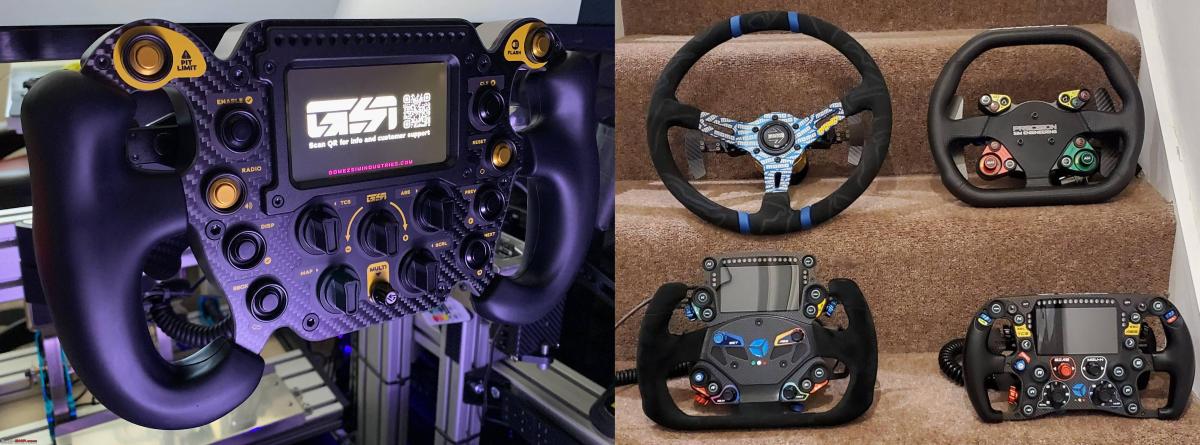
Steering wheels with buttons, paddle shifters and displays need to communicate with the wheel base and often the socket and communication protocol are proprietary. You therefore have to buy your steering wheel from the same manufacturer as the wheel base. Most manufacturers have multiple options available, you will be spoilt for choice. Many sim racers eventually buy a second and third wheel. The wheels connect to the wheel base (motor shaft) via a quick release mechanism; this makes it very easy to swap wheels.
Image: Fanatec QR.

Image: Accuforce QR.

Fanatec makes very sophisticated and technologically complicated wheels. Their wheels use through-shaft connectors with inductive coupling and wireless communication between the base and the wheel.
Image: CSL DD - shaft and back.

On the other hand, some other manufacturers make you connect a wire from the steering wheel to the base.
Image: Accuforce - wire connector.

Steering wheels with on-board displays can be customized to show the information you want via provided software. Fanatec and some other manufacturers also sell the button and shifter assembly (called button box) and quick release connectors separately so you can buy or build you own steering wheel and just mount the custom connectors and button box to make the wheel work with the base.
Image: DIY custom wheel from parts.
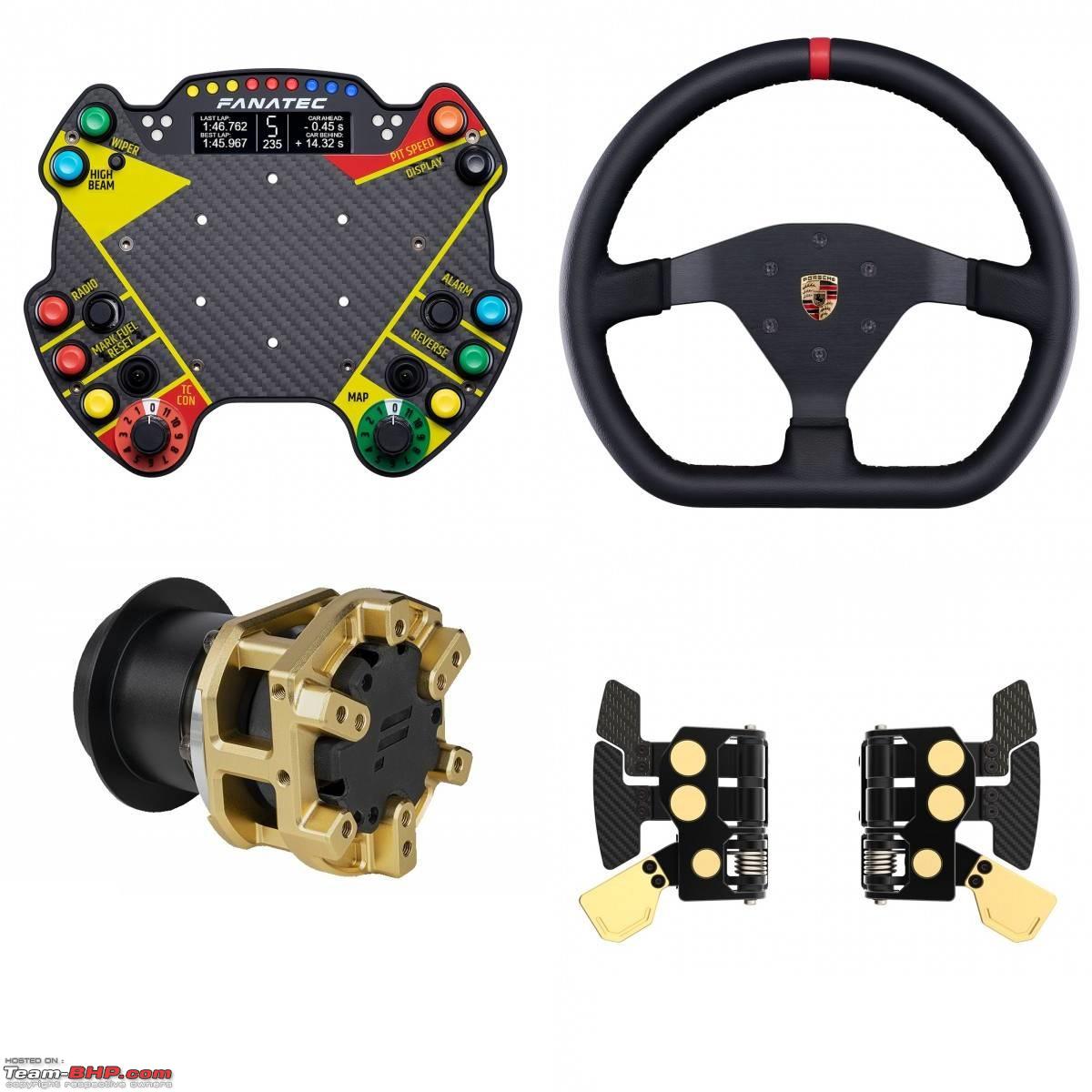
Pedals:
Pedals come in many varieties ranging from cheap, plastic, toy-like things with potentiometers to hydraulic pedals made from machined aluminium with load cell sensors. Good quality pedals make a world of difference to your driving experience.
Image: Fanatec Pedals.

Higher end pedals are generally made from steel or machined aluminium and can be configured for travel and position. You can buy 3 or 2 pedal setups. Load cell pedals contain strain guages and can accurately measure the pressure applied, just like the pedals used in F1 cars. Pedals connect to the wheel base. Quality pedals cost a lot. Pedals with hydraulics cost the most and feel very realistic; mid range pedals with load cells and springs should suffice for most.
Image: Simtag Hydraulic Pedals. Cost: - USD 1800.

Shifter and hand brake:
Commercially available sim racing wheels generally come with paddle shifters but some people prefer to buy a separate H-shifter. The more metal and machining required, higher the price.
In the sim racing communities, handbrakes are more of a must-have than a manual shifter. Like pedals, hand brakes also come in various quality and price brackets. Hand brakes with hall sensors and hydraulics cost more than simpler ones with a spring. It is also possible to diy a decent enough handbrake from scrap parts.
Image: Handbrake.

Cockpit:
The cockpit is the skeletal framework to which the above components are mounted including the driver's seat. On low-end setups with a Logitech G920 or similar you can get away with mounting the wheel base to a table, not so much with a direct drive wheel. A DD wheel generates enough torque to rip out screws and splinter a wooden table. You need a heavy, reinforced metal frame to mount the base. A good rig also has proper mounting points for pedals (inverted or normal), points to attach handbrakes and shifter and mounting points for the driver seat.
Image: Cockpits from NextLevelRacing.
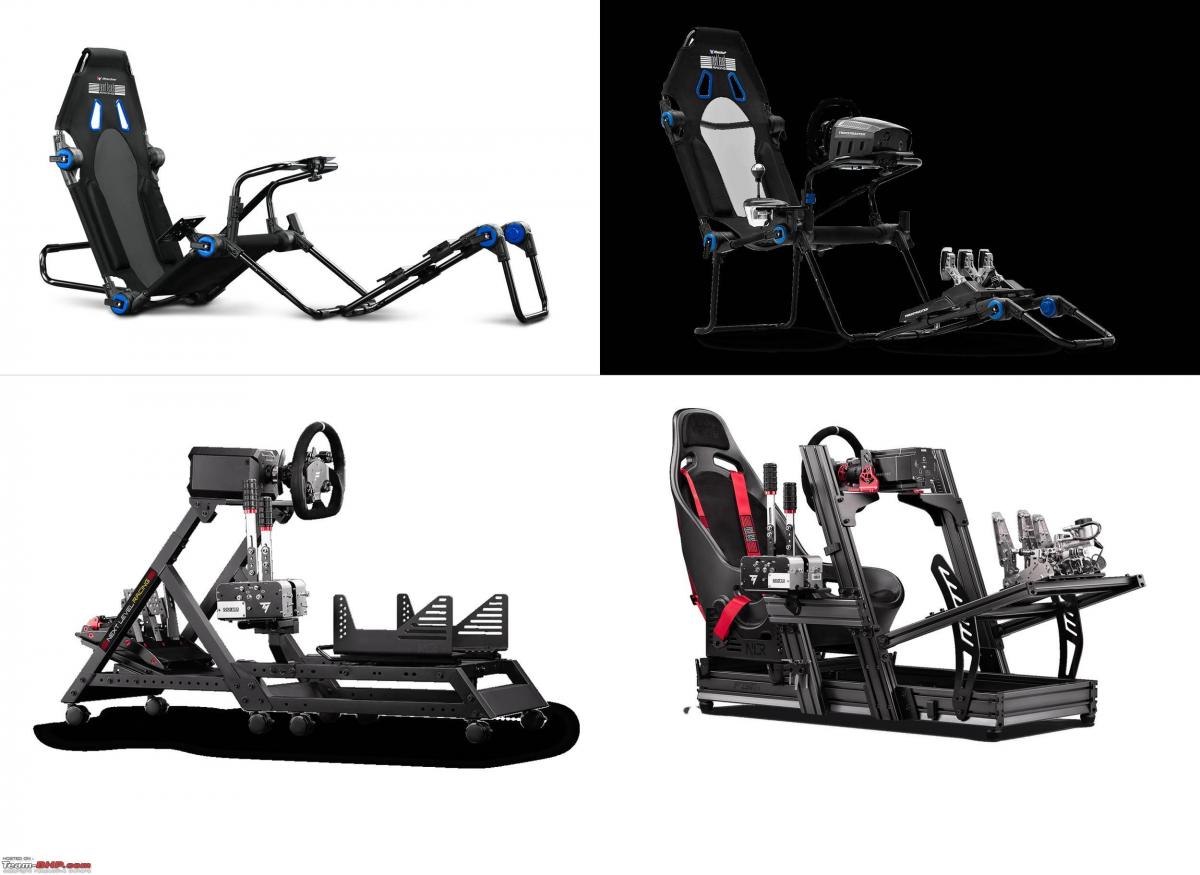
There are many companies selling steel cockpits. Some come with seats attached, some expect you to buy it separately or provide your own. Some people also fabricate their own rigs from steel or wood. Again, multiple options are available when it comes to seat types. For many people the most cost effective option is to get a real car seat from a scrapyard or their old vehicle.
Motion platforms:
To take the realism to another level you can purchase moving cockpits called motion platforms. These contraptions physically move you around like the simulators used by professional drivers and pilots.
Motion rigs can simulate roll, pitch, yaw and even traction loss (skidding) with the right hardware and are sold in upgradeable configurations based on the degree of freedom required. Over the past couple years prices have come down a lot thanks to increased competition. You can get a motion platform with roll, pitch and traction loss for under USD 4000. These aren't as popular due to the cost involved. Most sim racers have a stationary cockpit.
Motion rigs are powered by their own motors, controller and powersupply. The metal frame, motors and power supplies are a lot beefier since they are designed to support and jerk around (heh) an adult human. These rigs are meant for PC users since they require PC only software to function. The companies that make these use off-the-shelf industrial motors and hydraulics with custom designed firmware for heavy duty controllers. There is a DIY option for a full motion platform called the SFX 100.
Image: P3 Motion Platform.
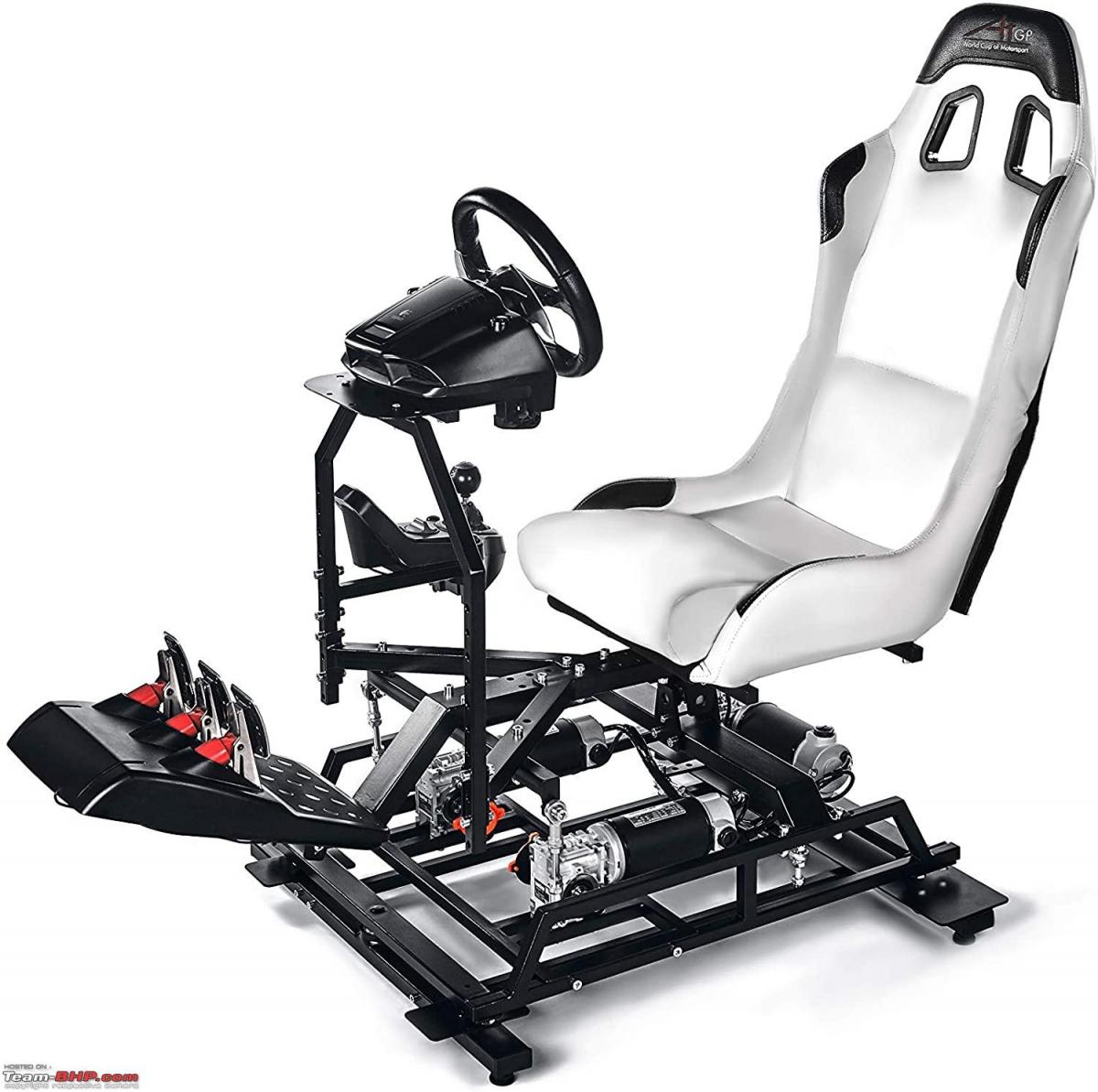
Bass shakers:
To simulate the vibrations of a moving vehicle, tactile transducers called bass shakers are used (also called butt kickers). These are low frequency speaker like devices with a moving weight attached to a voice coil. Bass shakers are driven by an amplifier connected to a PC/sound source. These are generally attached to the seat and cockpit frame.
Image: Bass Shakers.
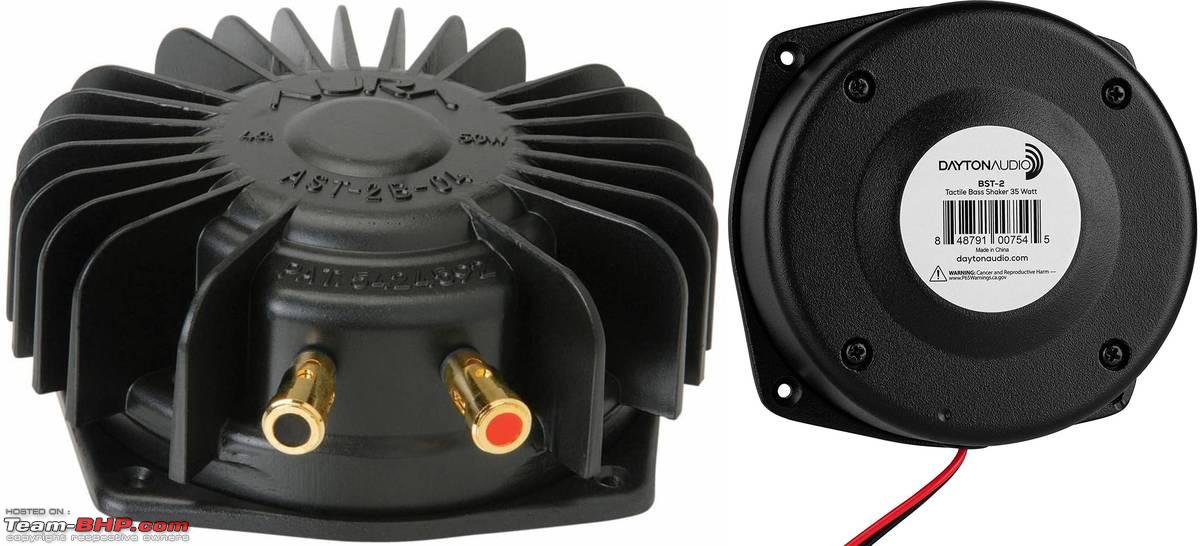
Display:
The choice of display depends on the graphics capability of your console or PC. These days there are 3 popular options:
- 3 monitor setup.
- Single Ultra wide monitor.
- VR headset.
Of the above three, a VR headset is the most immersive. All three display options require a PC with a good graphics card. Console racers and those without a beefy graphics card have to limit themselves to one monitor and lower graphics settings. Personally, I prefer the VR headset option, or in the absense of a headset, a 40 inch TV placed close to the wheel base running at 1080p resolution. I don't think there is much to explain here, the images below should suffice.
Image: Triple monitor and ultra wide setup. Also refer topmost image.
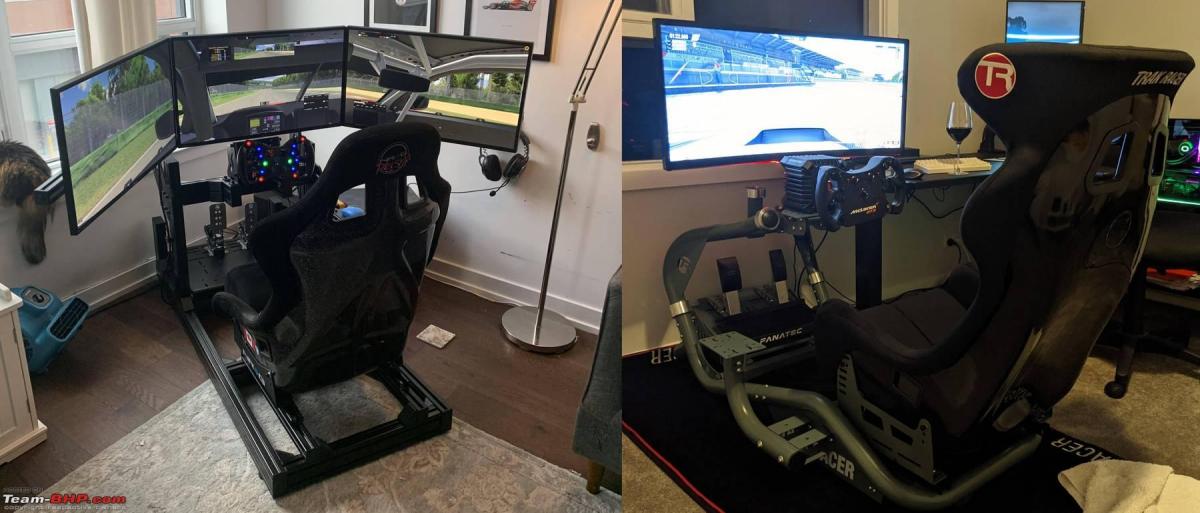
PC/Console and games:
Goes without saying, the PC /console is where the magic happens. The PC is the best sim platform by virtue of being an open platform. All PC sim games have tons of mods and dedicated communities to join and race with. If you are getting into sim racing, go with PC as your platform. Older games like Assetto Corsa have mods that have pushed the game beyond even what the developers imagined. It has a thriving community, tons of free cars, tracks and racers to race with. It also goes on sale regularly on Steam for less than Rs 300. Also, being an older game it runs well on older hardware (GTX 1650, GTX 1060 and above) and even on the latest generation of integrated GPUs at medium settings. Other popular sim racing games include: Automobilista 2, Assetto Corsa Competizione, Dirt Rally 1/2, Project Cars 2 and rFactor.
Racing sims are getting pretty realistic these days. Sim Racing games have laser scanned tracks, accurately modelled handling dynamics for licensed cars and realistic physics. And I mean REALISTIC - the games factor in tyre wear, tyre temperature, track conditions, weather conditions and a bunch of other variables to generate the signals and force feedback for the wheel base. Graphics have also improved to such an extent that a lot of people, prima facie, have trouble telling apart a game capture video from a real race video.
Image: Gameplay screenshots. Pretty realistic, yes?

Parting words:
Sim racing has never been more popular, realistic or affordable. The currently available consumer grade hardware is good enough even for training pro drivers and pilots. The CSL DD has brought high end DD technology to the budget segment and the competition is now heating up; we are going to have lots of new launches in the sub USD 500 range. Unfortunately, most of this gear is not available in this land of holy bovines. I hope some Chinese manufacturers get into this industry (since they already make those industrial motors others use) so we can finally have something available here. Most of the above photos of racing setups are from the subreddit - sim racing, you should check it out.
I started looking into sim racing because driving on our roads is a constant headache and more of a chore. Not to mention the strategically placed cows, jay walkers and superb roads studded with pot holes and speed breakers. Driving is no longer fun if you have to deal with all that. I would rather spend a couple of lakhs on a nice sim racing setup and drive/race for hours in the virtual world than deal with the chaos and filth of this reality.
Want to drink, drive and relax? Race a Caterham 420R through Donington Park and leave a mark.
Want to bend some fender? Crash a F1 car on Suzuka circuit, with your evening tea and biscuit.
Crotch spawns causing crotch pain? Take a Porsche 911 GT for a spin in the rain.
Wife nagging too much? Also causing crotch pain (!)? Floor a Ferrari on the Nordschleife again and again.
That's all folks! Thanks for reading.
Check out BHPian comments for more insights and information.



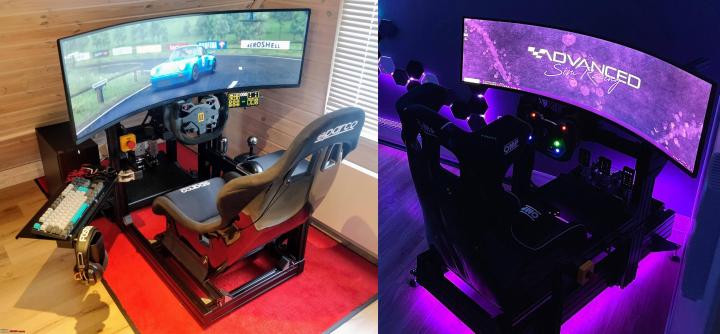
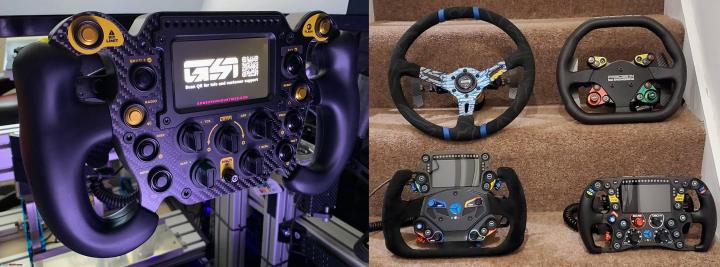
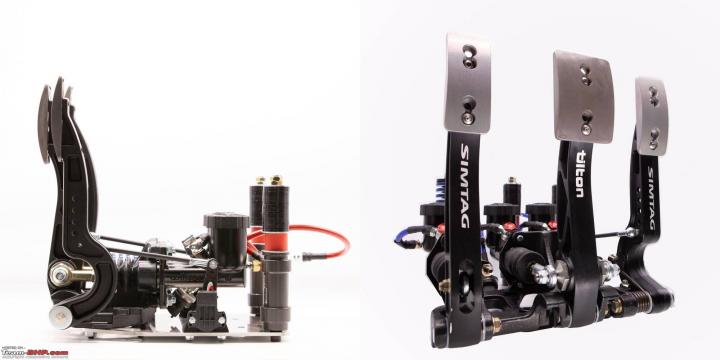














.jpg)
